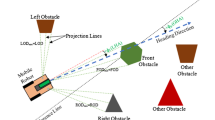Abstract
In this paper, an experimental study of a navigation system that allows a mobile robot to travel in an environment about which it has no prior knowledge is described. Data from multiple ultrasonic range sensors are fused into a representation called Heuristic Asymmetric Mapping to deal with the problem of uncertainties in the raw sensory data caused mainly by the transducer's beam-opening angle and specular reflections. It features a fast data-refresh rate to handle a dynamic environment. Potential-field method is used for on-line path planning based on the constructed gridtype sonar map. The mobile robot can therefore learn to find a safe path according to its self-built sonar map. To solve the problem of local minima in conventional potential field method, a new type of potential function is formulated. This new method is simple and fast in execution using the concept from distance-transform path-finding algorithms. The developed navigation system has been tested on our experimental mobile robot to demonstrate its possible application in practical situations. Several interesting simulation and experimental results are presented.
Similar content being viewed by others
References
Arkin, R. C.: Motor schema-based mobile robot navigation, Int. J. Robotics Res. 8(4) (1989), 92–112.
Borenstein, J. and Koren, Y.: Histogramic in-motion mapping for mobile robot obstacle avoidance, IEEE Trans. Robotics and Automation 7(4) (1991), 535–539.
Brooks, R. A.: A robust layered control system for a mobile robot, IEEE Trans. Robotics and Automation RA-2(1) (1986), 14–23.
Christensen, H. I., Kirkeby, N. O., Kristensen, S., Knudsen, L. and Granum, E.: Model-driven vision for in-door navigation, Robotics and Autonomous Systems 12(3–4) (1994), 199–207.
Crowley, J. L.: World modeling and position estimation for a mobile robot using ultrasonic ranging, in Proc. IEEE Int. Conf. Robotics and Automation, 1989, pp. 674–680.
Elfes, A.: Sonar-based real-world mapping and navigation, IEEE Trans. Robotics and Automation RA-3(3) (1987), 249–265.
Gilles, I. W.: Universal computer program for seeking of a collision free path for an industrial robot, in Proc. of 15th, ISIR Conf., Tokyo, 1985, pp. 935–942.
Hwang, Y. K. and Ahuja, N.: A potential field approach to path planning, IEEE Trans. Robotics and Automation 8(1) (1992), 23–32.
Khatib, O.: Real-time obstacle avoidance for manipulators and mobile robots, in Proc. IEEE Int. Conf. Robotics and Automation, 1985, pp. 500–505.
Kim, J. O. and Khosla, P. K.: Real-time obstacle avoidance using harmonic potential functions, IEEE Trans. Robotics and Automation 8(3) (1992), 338–349.
Koren, Y. and Borenstein, J.: Potential field methods and their inherent limitations for mobile robot navigation, in Proc. IEEE Int. Conf. Robotics and Automation, 1991, pp. 1398–1404.
Raschke, U. and Borenstein, J.: A comparison of grid-type map-building techniques by index of performance, in Proc. IEEE Int. Conf. Robotics and Automation, 1990, pp. 1828–1832.
Song, K. T. and Tai, J. C.: Fuzzy navigation of a mobile robot, in Proc. IROS'92, Raleigh, 1992, pp. 621–627.
Song, K. T. and Chang, C.C.: Ultrasonic sensor data fusion for environment recognition, in Proc. IROS'93, Yokohama, 1993, pp. 384–390.
Vandorp, J. and Van Brussel, H.: A reflexive navigation algorithm for an autonomous mobile robot, in Proc. IEEE Int. Conf. Multisensor Fusion and Integration for Intelligent Systems, Las Vegas, 1994, pp. 251–258.
Zelinsky, A.: Mobile robot map making using sonar, J. Robotics Systems 8(5) (1991), 557–577.
Zelinsky, A.: A mobile robot exploration algorithm, IEEE Trans. Robotics and Automation 8(6) (1992), 707–717.
Zhao, Y.: Theoretical and experimental evaluation of a local-minimum-recovery navigation algorithm, in Yuan F.Zheng (ed.), Recent Trends in Mobile Robots, Chapter 4, World Scientific, Singapore 1993, pp. 75–117.
Author information
Authors and Affiliations
Additional information
This work was supported partly by the National Science Council of Taiwan, ROC under the grant NSC-82-0422-E-009-321.
Rights and permissions
About this article
Cite this article
Song, KT., Chen, CC. Application of Heuristic Asymmetric Mapping for mobile robot navigation using ultrasonic sensors. Journal of Intelligent and Robotic Systems 17, 243–264 (1996). https://doi.org/10.1007/BF00339663
Received:
Accepted:
Issue Date:
DOI: https://doi.org/10.1007/BF00339663




